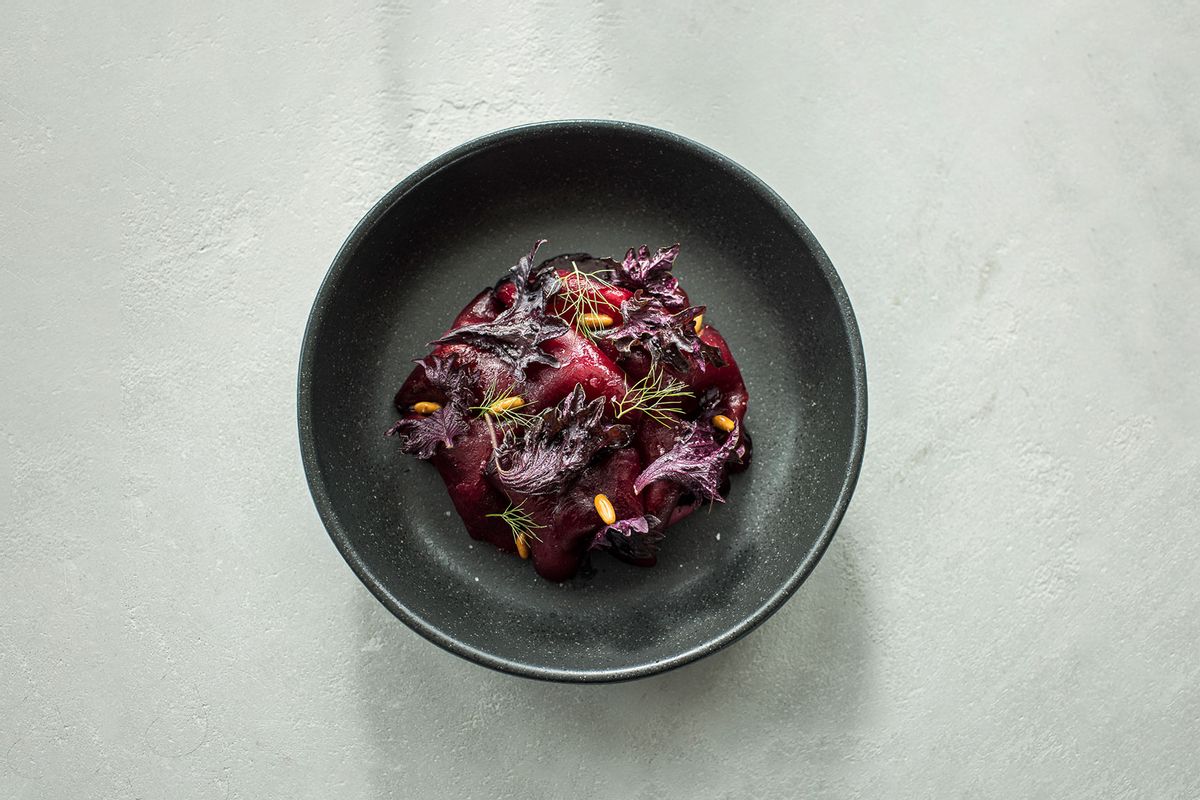I love mole.
I cook at home quite a lot, but there are certain foods and cuisines that I feel I am incapable of doing full justice to. Mole is one of those foods. While I may make a mole-inspired chili here and there, tackling an actual, legitimate mole is a whole different ballgame.
About five years ago or so, I was seeing a concert and wound up getting to the city a little earlier than necessary. I had about 90 minutes or so until the venue's doors opened, so I wound up stopping into a Mexican restaurant named Claro, which was around the corner and I had heard rave reviews about. I squeezed into a tiny table in the corner and ordered one of their moles — and it was mind-bogglingly terrific.
That quick meal in a matchbox-sized restaurant near the Gowanus Canal became one of my most cherished restaurant memories of the past decade. (And the Mitski show was pretty great, too.)
Rich, outrageously deep, wildly flavorful and amazingly complex, each bite offered something new and fresh to enjoy. The menu has since changed, but since then, I have been on a never-ending quest to further explore the realm of moles in all of their amazing diversity and flavor.
So when I heard that Chef Fernanda Serrano — the executive chef of elNico in Williamsburg, Brooklyn — is currently selling an intrepid, super-unique version of mole at her restaurant, I knew I wanted to chat with her. An accomplished chef with tenures at various fine dining restaurants and a Mexico City native, Serrano spoke with me about her pink-and-purple-tinged mole, what inspired it, the distinctions between Mexican and Mexican-American cuisine and the amazing journey of recipe development and menu production.
The following interview has been lightly edited for clarity and length.
I love the ingredients in your pink mole, from the tahini to the fennel, kumquat and pine nuts; how did you come up with the idea?
Pink mole is a mole variation from the town of Taxco in Guerrero, Mexico. Its original recipe includes beet to bring the vibrant pink color, sesame seeds and pine nuts. While on vacation with my mom around Greece, we asked for a beet and orange salad with a spicy sauce that reminded me of a mole. This idea stuck in my mind and while creating this dish, I wanted to create a pink vegan mole where instead of a protein, beets are the main ingredient of the dish.
By experimenting with different ways of cooking the vegetable, you can obtain different colors, which led to the different tones of pink in the dish. Tahini is made from sesame seeds and also has a nice creamy texture, which I used as a base for the mole sauce. Fennel brings freshness to the dish so it does not feel heavy and the kumquats add brightness and acidity to balance everything out.
How would you describe its flavor? Does the habanero impart a lot of heat?
One word that comes to mind when I eat this dish is fresh. It's so light and yet so full of flavors without being overwhelming. The heat of the habanero is not excessively present; each component speaks to the other [and] the chili adds the right amount of spice.
The setup for the pink mole recipe is amazing — the differences in colors, textures and flavors are incredible. What do you usually pair it with?
Leo Robitschek created the Kumquat Painkiller which was absolutely delicious and fresh. I always thought both were good together.
Want more great food writing and recipes? Subscribe to Salon Food's newsletter, The Bite.
Taxco has a similar pink-tinged mole; how did that factor into your creation of the recipe?
Taxco's pink mole is part of the inspiration for this dish. It is one of the lesser-known moles in Mexico, which I would love to educate people on because they are so delicious. In Mexico, we have more than 30 variations of mole in the country; each varies from region to region and also from family to family because, of course, everyone's grandma makes the best mole.
I know Mediterranean flavors influenced the mole — what was it like to combine Mexican Mediterranean cultures and flavors and ingredients?
Both Mexican and Mediterranean cuisines share the [same] passion for tradition and harmony of flavors, but we also share some ingredients in common. I always get excited when learning traditional cooking techniques from different places, but also try to see similarities between dishes. It is fun to try something new and think "Wow, this reminds me of something I ate as a child" or how I would cook an ingredient I've never used before using the techniques I grew up with.
This mole is vegan; is that the case for most traditional moles?
Mole is a sauce that sometimes will be cooked with pork fat, but also it will have a protein as a side, which for me was heavy. As a kid, I would choose calabacitas (zucchini) instead of chicken to have with my mole whenever we had it at home.
What was the most amount of ingredients you've seen go into a mole?
I had the opportunity to witness Elvia Leon, from Alfonsina in Oaxaca, prepare her famous Mole Negro; she is well known for being one of the best cooks in town. It was a long process as she does everything from scratch, but in her mole, there were around 20 ingredients. Not only did Elvia share her process and recipe, but also having the chance to know her and listen to her stories made this an impactful experience.
 Chef Fer (Photo by Eric Medsker)
Chef Fer (Photo by Eric Medsker)
What were some of the biggest lessons you learned at Pujol and Cosme before heading up elNico?
One of the biggest lessons I learned in both places is that every second matters: The importance of having a team of people that supports each other makes the difference on a busy service and the sense of belonging that makes you proud to be part of that team every day.
How would you contrast the cuisine in Mexico City with the Mexican-American food here in the states?
I will start by saying the difference is made by the ingredients. If you want to recreate a recipe you are used to cooking in Mexico, it likely will vary in the States because we do not have access to the same ingredients that are native to that region.
At elNico, we mitigate this by placing a lot of attention and resources on sourcing the best ingredients that are available including our chilis, corn and other components we use in our recipes.
We need your help to stay independent
What are some of your favorite Mexican dishes? What are some that you think aren't well known in America?
I always think of my mom's Cochinita Pibil, but I must say that Mari's chalupas are the best ones. Mari has been working with my family for more than 20 years; she's like a second mother to me and my brothers and she truly mastered my mom's chalupa green sauce recipe. Chalupas are small Mexican antojitos made of tortilla, green tomatillo sauce, chicken or beef. At home, Mari makes them with chicken, fresh white onion and white cheese.
Every time I go back home, this is the meal Mari welcomes me with the moment I walk in the door. Chalupas are not well known in America. I have crossed some Mexican food trucks that offer them, but it just doesn't taste the same.
I'm intrigued by the ingredients in some of your dishes: galangal in the scallop appetizer, nduja in the clam tostada, tzatziki in the tlayuda, xnipec and toum with the octopus. Such fascinating combinations – I'd love to hear about your menu planning and ideation process?
I get inspired when dining out at other restaurants, traveling, visiting a museum or just being in the company of my friends. I have been fortunate enough to travel the world, which opened my eyes to so many different ingredients, dishes and techniques that inspired me to incorporate them in my recipes.
Of course, the process of creating a recipe is tedious: Behind each component of a dish, time, research, tests and tastings are required just to create a recipe. It is beautiful, because during this process you might get an idea for another dish, so there is always a lot of paper around the table so we can jot down our notes and ideas.
While creating a recipe, I love having my sous chef, Stephanie, with me. Apart from being my best friend, she is the sous chef at elNico and the process for me needs to be with someone I trust, but also have fun with. The creative process starts by setting up what dish I [want] to have on the menu (ex. taco, aguachile, tostada, etc). Then we start researching together; we love to explore the market to get inspired by what's in season and the vibrant colors of fresh produce. After I decide which ingredients to use, we start brainstorming and experimenting with different recipes we're creating.
One of my favorite stories was when we were trying to find the perfect ratio of garlic for one of our sauces, the Toum, that is in the Pulpo Pibil. We ate way too much garlic throughout the day and honestly, I think we smelled like it for a week.
Plating is another big element of this process. When it's time to present the final result, I start to feel like an artist releasing a new track — all the thought, the work, the hours (and garlic!) leading up to this moment and it's so beautiful to see and taste everything when it comes together. The best part is witnessing others enjoy these recipes as well.

Shares